Government Proposals Are Scored and Not Read
Most business development professionals in the government contracting (GovCon) marketspace know that the heading to this paragraph is a true statement. For those who have never known this, please always remember it now that you have been informed. 
What is a strength though? The Federal Acquisition Regulation (FAR) Part 15-305 defines a strength as a feature that:
- Exceeds a likely or known contract requirement in a way that is beneficial to the government.
- Increases the likelihood of mission or contract performance.
I like to say that if you do not have the strengths for a particular section identified in advance of the writing, then why are you writing? The real question, though, is how do you come to have the strengths that will score the most points based upon the solicitation’s evaluation factors and subfactors as specified in Section M? The obvious answer when addressing the requirements as specified in Section C is to write a compliant, convincing, and compelling narrative. This is true; however, my almost 30 years in GovCon have proven to me that when you just ask or assign individuals to write to the requirements, you are often setting the proposal response up for failure. This is because, when this is done, the strengths needed to score the points most often are “discovered” in a reactive manner versus “designed” in a proactive way.
Typically, “strengths discovery” comes during pink and red team reviews and, hopefully, definitely comes when an evaluator is reading your response. “Strength design”, though, comes from deriving the strengths from numerous types of upfront analyses before any writing ever occurs. Here is another way that I like to describe it: discovering strengths after the fact is like building security into your software after you already have deployed it – it is too late to mitigate threats and costly to address. In contrast, designing pre-identified strengths upfront into your writing is similar to building security into your software before it is ever deployed – with this approach, you are more certain of a positive outcome.
Foundational Analyses to Do Before Strength Identification
Hot Button Issue Analysis
Know and validate with the customer the top 4-7 hot-button issues driving the procurement and why they are issues. The word “issue” is a general term though. The following terms are also valid in place of the word issue when trying to understand what is driving a government customer to go to industry for help by way of a competitive procurement: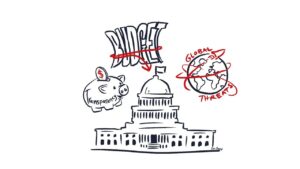
- Angst
- Challenge
- Concern
- Distress
- Fear
- Grief
- Problem
- Stress
- Trouble
- Worry
Key Factor Analysis
Key factors are what any company bidding on a competitive pursuit must bring to the table to address the government customer’s hot-button issues. They are like table stakes in a game of poker. They are not the solution but help frame it. So, why key factors?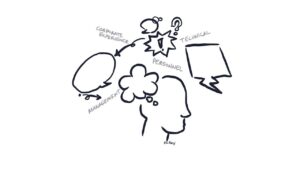
- They address the customer’s hot-button issues.
- They address technical, management, personnel, and corporate experience perspectives.
- They provide a framework for your company’s discriminators.
- They sell “without selling.”
- They address evaluation criteria.
With both issue and key factor analyses, it is important to understand the psychographics of the government customer in terms of:
- Personality type, i.e. leader, egotist, friendly, thinker, visionary.
- Role type, i.e. influencer, decider, advisor, recommender, participant.
- Relationship towards your company, i.e. advocate, admirer, agnostic, adversary, afflicter.
- Evaluation panel member, i.e. yes, no.
The importance of these foundational analyses is that they help you find out what the customer really values.
Analyses to Identify Strengths
There are a number of competitive assessment techniques that can be used to identify strengths for your company. They are: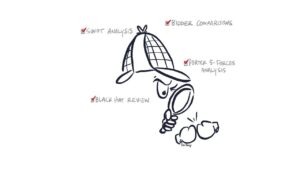
- Strength, Weakness, Opportunity, Threat (SWOT) Analysis
- Bidder Comparison
- Porter Five-Forces Analysis
- Black Hat Review
With each of the aforementioned types of techniques, you are identifying strengths and weakness for both your company and the competition so that you can:
- Highlight your company’s strengths.
- Minimize your company’s weaknesses.
- Neutralize the likely competitors’ strengths.
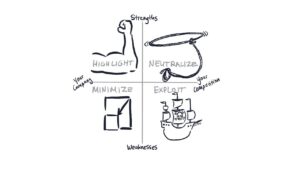
- Highlight the likely competitors’ weaknesses.
- Counter how a likely competitor could exploit your weakness.
- Counter how a likely competitor could neutralize your strength.
Many companies often just do a SWOT Analysis. The problem with this is that when you do a particular competitive assessment technique, you are using a certain mental model as you dialogue with your peers in the exercise at hand. When you use another technique, e.g., Bidder Comparison where you are making “apples to apples” comparisons against the competition, you are using a different mental model as you dialogue with your peers. This very often helps you to identify strengths that you might not have otherwise identified if you just used one technique.
From the competitive assessment, you can perform an analysis to qualify discriminators for your company if they meet all of the following criteria: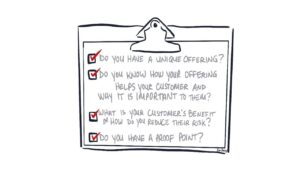
- You have a unique feature, i.e. you know it is unlikely that any competitor pursuing the same deal can make the same claim in a credible way.
- You know that what your company is proposing helps the customer. You know that it is important to them and meets a unique need or desire, particularly to known decision-makers and key influencers. It is important to validate your potential discriminators with the customer.
- The benefit provided or risk mitigated is clear to the customer and its constituents. Try to quantify benefits whenever possible. This makes them stronger in the eyes of evaluators.
- You can show proof that what you are proposing has delivered these benefits before.
Likewise, any weaknesses for your company and even potential threats identified during the competitive assessment or a gap analysis can be aggregated into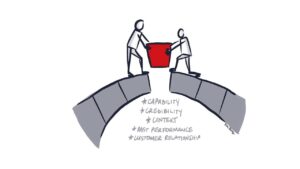 a list and thinking can be applied on how to turn any negatives into positives. For example, maybe your company received a poor Contractor Performance Assessment Reporting System rating due to a rocky start during a contract transition almost five years earlier. You can focus on the quantifiable benefits that the customer was able to successfully deliver to its own stakeholders since then, as well as the cumulative experience that the incumbent team now possesses to include the many lessons learned, which would be lost if the contract were to turn over to a new company.
a list and thinking can be applied on how to turn any negatives into positives. For example, maybe your company received a poor Contractor Performance Assessment Reporting System rating due to a rocky start during a contract transition almost five years earlier. You can focus on the quantifiable benefits that the customer was able to successfully deliver to its own stakeholders since then, as well as the cumulative experience that the incumbent team now possesses to include the many lessons learned, which would be lost if the contract were to turn over to a new company.
In addition, there are a number of analyses that can be done across what I like to call the Integrated Solution Set:
- Team, i.e. Prime and Teaming Partners
- Past performance
- Leadership team (i.e., Key Personnel)
- Technical approach/technical solution
- Management approach
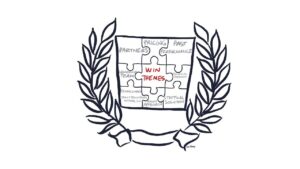
- Methods, processes, tools, and techniques
- Staffing solution
- Price-to-win and basis-of-estimate
Never think that the solution to a potential government customer is just composed of the technical aspects of your offering, e.g. software, and hardware. Instead, look at it more broadly as “a set of things”, as described in the aforementioned list, that provides to the customer (for example, the United States Department of Veterans Affairs) and/or the customer’s customer (for example, veterans), either benefit realization (preferably quantifiable) or risk mitigation. Ultimately, the aim of all of the different types of analyses used to identify strengths is to aggregate them into an inventory of strengths.
What Do You Do with the Inventory of Strengths?
When you really think about it, a competitive GovCon bid is really like a basketball game: the team with the most points wins. If you follow the industry-proven advice in this article, you will have created an inventory of strengths consisting of dozens and dozens of strengths. Some will likely meet the criteria of a discriminator too. Review, adjudicate, and prioritize the many strengths in the inventory in terms of ones that must be addressed, are desirable to address, or are to be ignored.
Create a “digital thread” in Microsoft Excel or Word that traces each respective issue/key factor to the associated requirement(s). Then trace this information to the particular strength that addresses the preceding items identified in the thread. Finally, map everything in the thread to the corresponding evaluation factor/subfactor that is fulfilled. This helps make assignment of the points for the strength by the evaluator traceable, irrefutable, defensible, and explainable. This enables answering the most important question in a competitive pursuit: “Why your company?”
Allocate each digital thread against a compliant requirements-driven outline (RDO) to support its elaboration. Use the respective elaborated RDO sections to inform writers of the pre-identified strengths assigned to them that they must embed into their writing. Tell them that the strength must be presented in a narrative, call-out box, anchor graphic, or table action caption statement in such a manner that it pops out to the eye of an evaluator within 7-10 seconds. This helps make identification of the strength “evaluator friendly.” Government evaluators easily move on to the next section of your proposal if the strengths are not readily evident to them, resulting in you not scoring any points for your proposal development efforts.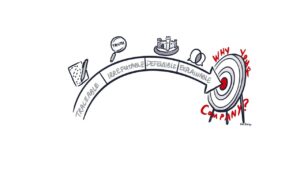
From my experience doing capture over many years, the people who get most excited by this approach to developing an inventory of strengths, i.e. digital threads of “authentic intelligence”, in advance of any proposal writing are those on the proposal team. This is because you are setting their efforts up for success. They are not going to just produce an output, i.e. a compliant, on-time proposal, but more likely an outcome, i.e. a competitive win, because the company’s proposal is compliant, convincing, and compelling.
You Do Not Get the Strengths to Score the Points in Competitive GovCon Bids Without Doing the Necessary Upfront Analyses
This approach might seem unconventional across the GovCon industry if you are a business developer, capture manager, or proposal manager; however, it is proven by hundreds of millions of dollars in competitive wins. The truth is that if you want to win a competitive GovCon pursuit, there are not any shortcuts.
In fact, do not even be fooled by the hysteria about AI being pushed by AI vendors to the GovCon industry. AI will not be able to generate an inventory of strengths embedded in digital threads of customer and competitor context in advance of proposal writing. If you want “authentic intelligence,” you are still going to have to do the necessary upfront analyses collaboratively to win.
Peter Lierni (CAP.APMP & CP.APMP) is the founder of Solutioneering and originator of the Solution Engineering Framework™, which is a simple, yet powerful, deliberate and collaborative, engineering-based approach to designing winning proposal solutions. The Solution Engineering Framework is also automated as a software called “SET™”. Contact him at plierni@solutioneering.company to learn more.



Join the Conversation